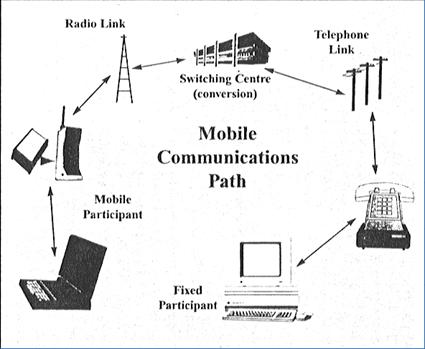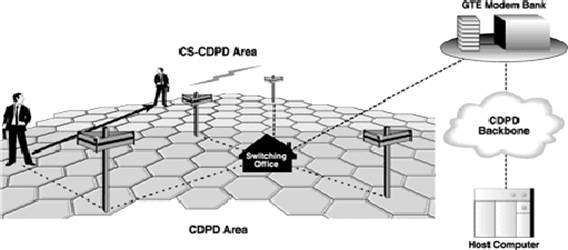paper no: Custom1
last update: 20/05/08
MOBILE COMPUTING
(past,present,future)
INTRODUCTION :
Mobile Computing : A technology that allows transmission of data, via a computer, without having to be connected to a fixed physical link.
Mobile voice communication is widely established throughout the world and has had a very rapid increase in the number of subscribers to the various cellular networks over the last few years. An extension of this technology is the ability to send and receive data across these cellular networks. This is the principle of mobile computing.
Mobile data communication has become a very important and rapidly evolving technology as it allows users to transmit data from remote locations to other remote or fixed locations. This proves to be the solution to the biggest problem of business people on the move - mobility.
In this article we give an overview of existing cellular networks and describe in detail the CDPD technology which allows data communications across these networks. Finally, we look at the applications of Mobile Computing in the real world.
DATA COMMUNICATIONS: Data Communications is the exchange of data using existing communication networks. The term data covers a wide range of applications including File Transfer (FT), interconnection between Wide-Area-Networks (WAN), facsimile (fax), electronic mail, access to the internet and the World Wide Web (WWW).

Mobile Communications Overview
Data Communications have been achieved using a variety of networks such as PSTN, leased-lines and more recently ISDN (Integrated Services Data Network) and ATM (Asynchronous Transfer Mode) /Frame Relay. These networks are partly or totally analogue or digital using technologies such as circuit - switching, packet - switching e.t.c.
Circuit switching implies that data from one user (sender) to another (receiver) has to follow a prespecified path. If a link to be used is busy , the message can not be redirected , a property which causes many delays.
Packet switching is an attempt to make better utilisation of the existing network by splitting the message to be sent into packets. Each packet contains information about the sender, the receiver, the position of the packet in the message as well as part of the actual message. There are many protocols defining the way packets can be send from the sender to the receiver. The most widely used are the Virtual Circuit-Switching system , which implies that packets have to be sent through the same path, and the Datagram system which allows packets to be sent at various paths depending on the network availability. Packet switching requires more equipment at the receiver, where reconstruction of the message will have to be done.
The introduction of mobility in data communications required a move from the Public Switched Data Network (PSDN) to other networks like the ones used by mobile phones. PCSI has come up with an idea called CDPD (Cellular Digital Packet Data) technology which uses the existing mobile network (frequencies used for mobile telephony).
Mobility implemented in data communications has a significant difference compared to voice communications. Mobile phones allow the user to move around and talk at the same time; the loss of the connection for 400ms during the hand over is undetectable by the user. When it comes to data, 400ms is not only detectable but causes huge distortion to the message. Therefore data can be transmitted from a mobile station under the assumption that it remains stable or within the same cell.
CDPD TECHNOLOGY : THE HOT COOKIE
Today, the mobile data communications market is becoming dominated by a technology called CDPD.
There are other alternatives to this technology namely Circuit Switched Cellular, Specialised Mobile Radio and Wireless Data Networks. As can be seen from the table below the CDPD technology is much more advantageous than the others.
|
Cellular Digital Packet Data (CDPD) |
Circuit Switched Cellular |
Specialized Mobile Radio (Extended) |
Proprietary Wireless Data Networks |
Speed |
best |
best |
good |
good |
Security |
best |
better |
good |
better |
Ubiquity |
best |
best |
good |
better |
Cost of Service |
best |
better |
better |
good |
Cost of Deployment |
best |
best |
better |
good |
Mobility |
best |
good |
better |
good |
Interoperability |
best |
good |
good |
better |
CDPD's principle lies in the usage of the idle time in between existing voice signals that are being sent across the cellular networks. The major advantage of this system is the fact that the idle time is not chargeable and so the cost of data transmission is very low. This may be regarded as the most important consideration by business individuals.
CDPD networks allow fixed or mobile users to connect to the network across a fixed link and a packet switched system respectively. Fixed users have a fixed physical link to the CDPD network. In the case of a mobile end user, the user can, if CDPD network facilities are non-existent, connect to existing circuit switched networks and transmit data via these networks. This is known as Circuit Switched CDPD (CS-CDPD).

Circuit Switched CDPD
Service coverage is a fundamental element of providing effective wireless solutions to users and using this method achieves this objective. Where CDPD is available data is split into packets and a packet switched network protocol is used to transport the packets across the network. This may be of either Datagram Virtual Circuit Switching form.
The data packets are inserted on momentarily unoccupied voice frequencies during the idle time on the voice signals. CDPD networks have a network hierarchy with each level of the hierarchy doing its own specified tasks.
For Further more download pdf...
|